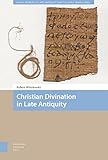Christian divination in late antiquity / Robert Wiśniewski ; translated by Damian Jasiński.
Material type: TextLanguage: English Original language: Polish Series: Social worlds of late antiquity and the early Middle AgesPublisher: Amsterdam : Amsterdam University Press, [2020]Description: 1 online resourceContent type:
TextLanguage: English Original language: Polish Series: Social worlds of late antiquity and the early Middle AgesPublisher: Amsterdam : Amsterdam University Press, [2020]Description: 1 online resourceContent type: - 9789048541010
- 9048541018
- Wróżbiarstwo Chrześcijańskie w późnym antyku, czyli, Jak poznać przyszlość i nie utracić zbawienia. English
- Divination -- History
- Occultism -- Religious aspects -- Christianity -- History of doctrines -- Early church, ca. 30-600
- Christianity and culture
- Divination -- Histoire
- Early history: c. 500 to c. 1450/1500
- History of religion
- HISTORY -- Ancient -- General
- Christianity and culture
- Divination
- 30-600
- Late Antiquity - Divination - History of Christianity
- 261.5/1309015 23
- 203.20935 23
- BR195.O33 S57813 2020
- BL613
- online - EBSCO
| Item type | Current library | Call number | URL | Status | Notes | Barcode | |
|---|---|---|---|---|---|---|---|
 eBook
eBook
|
Biblioteca "Angelicum" Pont. Univ. S.Tommaso d'Aquino Nuvola online | online - EBSCO (Browse shelf(Opens below)) | Online access | Not for loan (Accesso limitato) | Accesso per gli utenti autorizzati / Access for authorized users | (ebsco)2658395 |
Frontmatter -- Table of Contents -- List of Abbreviations -- List of Illustrations -- Introduction -- 1. Attitudes to Divination -- 2. Prophets -- 3. Take and Read -- 4. Books and Bones -- 5. Divinatory Lots -- 6. Interrogating Demoniacs -- 7. Incubation -- Conclusions -- Bibliography -- Index
In Late Antiquity, people commonly sought to acquire knowledge about the past, the present, and the future, using a variety of methods. While early Christians did not doubt that these methods worked effectively, in theory they were not allowed to make use of them. In practice, people responded to this situation in diverse ways. Some simply renounced any hope of learning about the future, while others resorted to old practices regardless of the consequences. A third option, however, which emerged in the fourth century, was to construct divinatory methods that were effective yet religiously tolerable. This book is devoted to the study of such practices and their practitioners, and provides answers to essential questions concerning this phenomenon. How did it develop? How closely were Christian methods related to older, traditional customs? Who used them and in which situations? Who offered oracular services? And how were they treated by the clergy, intellectuals, and common people?
Online resource; title from digital title page (viewed on December 08, 2020).


